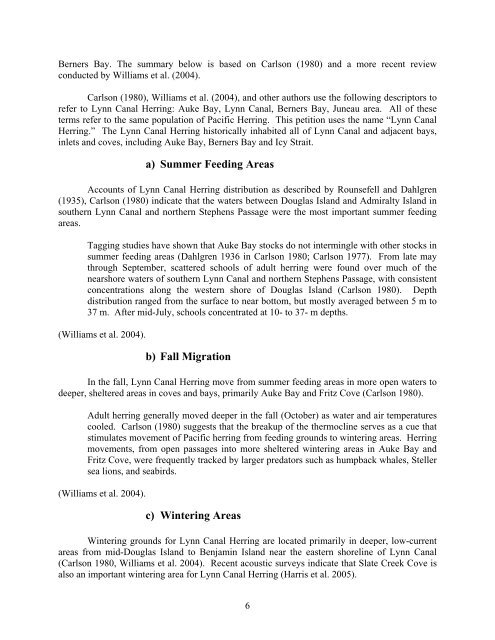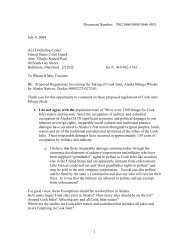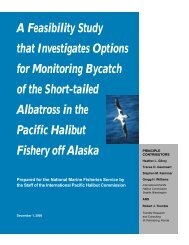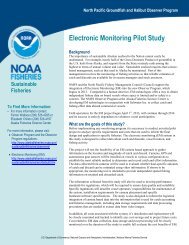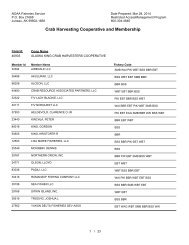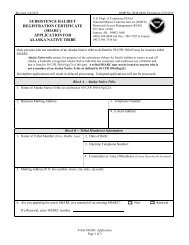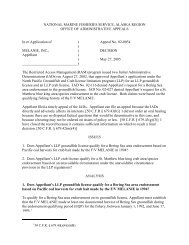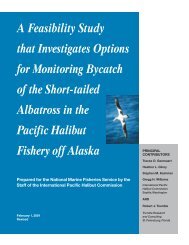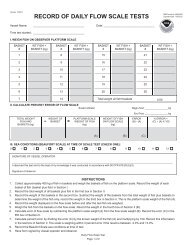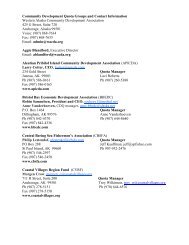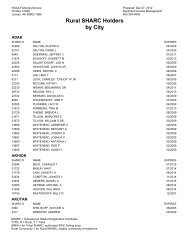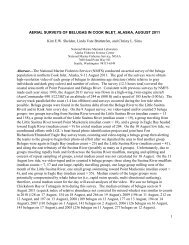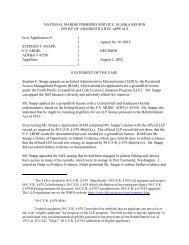Petition to List Lynn Canal Pacific Herring under the Endangered ...
Petition to List Lynn Canal Pacific Herring under the Endangered ...
Petition to List Lynn Canal Pacific Herring under the Endangered ...
You also want an ePaper? Increase the reach of your titles
YUMPU automatically turns print PDFs into web optimized ePapers that Google loves.
Berners Bay. The summary below is based on Carlson (1980) and a more recent review<br />
conducted by Williams et al. (2004).<br />
Carlson (1980), Williams et al. (2004), and o<strong>the</strong>r authors use <strong>the</strong> following descrip<strong>to</strong>rs <strong>to</strong><br />
refer <strong>to</strong> <strong>Lynn</strong> <strong>Canal</strong> <strong>Herring</strong>: Auke Bay, <strong>Lynn</strong> <strong>Canal</strong>, Berners Bay, Juneau area. All of <strong>the</strong>se<br />
terms refer <strong>to</strong> <strong>the</strong> same population of <strong>Pacific</strong> <strong>Herring</strong>. This petition uses <strong>the</strong> name “<strong>Lynn</strong> <strong>Canal</strong><br />
<strong>Herring</strong>.” The <strong>Lynn</strong> <strong>Canal</strong> <strong>Herring</strong> his<strong>to</strong>rically inhabited all of <strong>Lynn</strong> <strong>Canal</strong> and adjacent bays,<br />
inlets and coves, including Auke Bay, Berners Bay and Icy Strait.<br />
a) Summer Feeding Areas<br />
Accounts of <strong>Lynn</strong> <strong>Canal</strong> <strong>Herring</strong> distribution as described by Rounsefell and Dahlgren<br />
(1935), Carlson (1980) indicate that <strong>the</strong> waters between Douglas Island and Admiralty Island in<br />
sou<strong>the</strong>rn <strong>Lynn</strong> <strong>Canal</strong> and nor<strong>the</strong>rn Stephens Passage were <strong>the</strong> most important summer feeding<br />
areas.<br />
Tagging studies have shown that Auke Bay s<strong>to</strong>cks do not intermingle with o<strong>the</strong>r s<strong>to</strong>cks in<br />
summer feeding areas (Dahlgren 1936 in Carlson 1980; Carlson 1977). From late may<br />
through September, scattered schools of adult herring were found over much of <strong>the</strong><br />
nearshore waters of sou<strong>the</strong>rn <strong>Lynn</strong> <strong>Canal</strong> and nor<strong>the</strong>rn Stephens Passage, with consistent<br />
concentrations along <strong>the</strong> western shore of Douglas Island (Carlson 1980). Depth<br />
distribution ranged from <strong>the</strong> surface <strong>to</strong> near bot<strong>to</strong>m, but mostly averaged between 5 m <strong>to</strong><br />
37 m. After mid-July, schools concentrated at 10- <strong>to</strong> 37- m depths.<br />
(Williams et al. 2004).<br />
b) Fall Migration<br />
In <strong>the</strong> fall, <strong>Lynn</strong> <strong>Canal</strong> <strong>Herring</strong> move from summer feeding areas in more open waters <strong>to</strong><br />
deeper, sheltered areas in coves and bays, primarily Auke Bay and Fritz Cove (Carlson 1980).<br />
Adult herring generally moved deeper in <strong>the</strong> fall (Oc<strong>to</strong>ber) as water and air temperatures<br />
cooled. Carlson (1980) suggests that <strong>the</strong> breakup of <strong>the</strong> <strong>the</strong>rmocline serves as a cue that<br />
stimulates movement of <strong>Pacific</strong> herring from feeding grounds <strong>to</strong> wintering areas. <strong>Herring</strong><br />
movements, from open passages in<strong>to</strong> more sheltered wintering areas in Auke Bay and<br />
Fritz Cove, were frequently tracked by larger preda<strong>to</strong>rs such as humpback whales, Steller<br />
sea lions, and seabirds.<br />
(Williams et al. 2004).<br />
c) Wintering Areas<br />
Wintering grounds for <strong>Lynn</strong> <strong>Canal</strong> <strong>Herring</strong> are located primarily in deeper, low-current<br />
areas from mid-Douglas Island <strong>to</strong> Benjamin Island near <strong>the</strong> eastern shoreline of <strong>Lynn</strong> <strong>Canal</strong><br />
(Carlson 1980, Williams et al. 2004). Recent acoustic surveys indicate that Slate Creek Cove is<br />
also an important wintering area for <strong>Lynn</strong> <strong>Canal</strong> <strong>Herring</strong> (Harris et al. 2005).<br />
6


